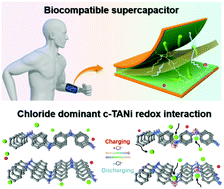Crystalline tetra-aniline with chloride interactions towards a biocompatible supercapacitor†
Abstract
Recent advances in wearable and implantable electronics have increased the demand for biocompatible integrated energy storage systems. Conducting polymers, such as polyaniline (PANi), have been suggested as promising electrode materials for flexible biocompatible energy storage systems, based on their intrinsic structural flexibility and potential polymer chain compatibility with biological interfaces. However, due to structural disorder triggering insufficient electronic conductivity and moderate electrochemical stability, PANi still cannot fully satisfy the requirements for flexible and biocompatible energy storage systems. Herein, we report a biocompatible physiological electrolyte activated flexible supercapacitor encompassing crystalline tetra-aniline (c-TANi) as the active electrode material, which significantly enhances the specific capacitance and electrochemical cycling stability with chloride electrochemical interactions. The crystallization of TANi endows it with sufficient electronic conductivity (8.37 S cm−1) and a unique Cl− dominated redox charge storage mechanism. Notably, a fully self-healable and biocompatible supercapacitor has been assembled by incorporating polyethylene glycol (PEG) with c-TANi as a self-healable electrode and a ferric-ion cross-linked sodium polyacrylate (Fe3+-PANa)/0.9 wt% NaCl as a gel electrolyte. The as-prepared device exhibits a remarkable capacitance retention even after multiple cut/healing cycles. With these attractive features, the c-TANi electrode presents a promising approach to meeting the power requirements for wearable or implantable electronics.

- This article is part of the themed collection: Special issue in honour of Seth Marder


 Please wait while we load your content...
Please wait while we load your content...